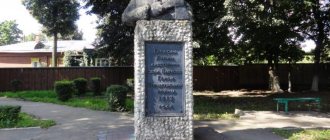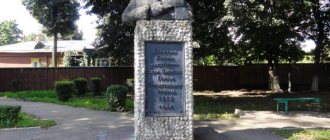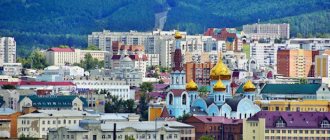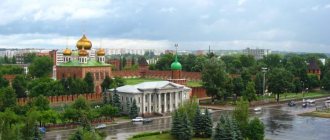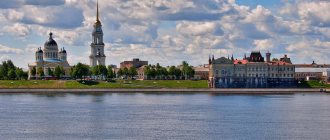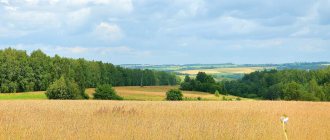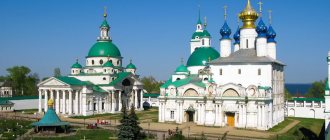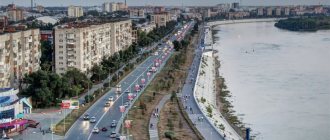Monuments and architecture
The most important monuments of the city are:
- Monument to Georgy Sviridov. A native of the Kursk province, Georgy Sviridov was known in the Soviet Union. The monument to the composer was erected in 2005.
- Monument to Kursk Antonovka. Local legend says that Red Square was built on the site of an apple orchard. In order to compensate for the moral damage from this loss, a bronze apple 2 meters high was installed on it. The opening of the image of an apple was timed to coincide with the Apple Savior.
- Sculpture Kursk Nightingale. Located on the street. K. Marx, 68.
There are works of architecture in Kursk:
- Philharmonic - 2, formerly the House of Officers. The building, which previously belonged to the Kursk Noble Assembly, was burned by the Nazis. In the 60s, it was completely restored with funds from the Ministry of Defense and became the House of Officers. This 3-storey building in the eclectic style is part of the architectural ensemble framing Red Square.
- Nelidov estate. The building was built in pseudo-Gothic style in the 19th century. You can find 200-year-old oak trees here.
- Annenkov estate. The building, built in the 18th century, has survived to this day without destruction or reconstruction.
The city is also decorated with the architecture of such structures as buildings:
- bank near the House of Books;
- medical university;
- theater named after Pushkin;
- circus with a monument to Nikulin and Shuidin;
- shopping centers;
- Prometheus store on the street. Gaidar, 16;
- Denisyev's house built in the 18th century, currently the building of city hospital No. 1;
- Hetman Mazepa's chambers of the 18th century.
Interesting examples of church architecture
Against the backdrop of modern business centers, ancient temples look solemn and majestic. Such development is typical for many settlements in our country, but local architecture still deserves attention. Kursk is rich in churches, and in its surroundings there are several ancient monasteries. It is definitely worth visiting the Sergius-Kazan Cathedral, located on Maxim Gorky Street. In terms of its decoration, it is not inferior to the churches of Moscow, it operates today, and it is easy to get to services here. The Znamensky Monastery has also survived to this day in good condition. Some of the buildings are not used for their intended purpose; in different years they housed both a factory and a warehouse. But today part of the monastery has been restored and is functioning. Speaking about the sights of Kursk, one cannot ignore the Church of the Resurrection of Christ. This is a relatively small red brick building with rich interior decoration.
Flora of the Kursk region
Forests occupy a small part of the Kursk region. Pine forests are extremely rare and most often they are planted by humans. In these forests you can find tricolor violets, hare cabbage, and a variety of lichens. Pine forests are famous for a large number of butterfish.
Aspen forests are also rare in the Kursk region. They replace cut down tree species. Most often, oaks, ash, maples, and elms grow in these forests, which gradually transform the aspen forest into an oak grove.
Birch forests consist of birches themselves and a large number of shrubs and grasses. Here you can find bluegrass, meadow fescue, common bentgrass, ranunculus, wild strawberry and many other plants.
Some of the tallest forests are alder. They are very damp, the trunks are entwined with vines. Raspberries and currants grow well in such conditions.
The oak forests of the Kursk region are located along the river banks. The most common species found there are English oak, as well as common ash, Norway maple and elm. And under these tall trees grow forest apple trees, pear trees and field maples.
The shrubs of oak forests are quite diverse: thickets of hazel, buckthorn, euonymus and hawthorn.
Some types of mushrooms grow in the Kursk region, such as porcini mushrooms, russula and boletus mushrooms.
The meadows are covered with different types of grasses and shrubs. Bluegrass and wheatgrass grow on dry soil. Timothy and bromegrass, buttercup, adonis and others are located in more humid areas. But on the banks of rivers and lakes, beckmania and sedge grow.
Reeds, reeds, willows and alders grow in the swamps, lakes, rivers and ponds of the Kursk region. You can also find a large number of water lilies, algae, and egg capsules.
City museums
Kursk (the city's attractions are associated with its history) has many museums.
Listing a few of them:
Art Gallery named after A. A. Deineka. Contains works by Russian artists and foreign masters of fine art. Paintings, drawings, icons, works of sculptors, porcelain, handicrafts and other genres of human creativity are exhibited here. The exhibition is based on paintings and drawings by Alexander Deineka, as well as works by Kursk artists. You can watch a film about the work of the talented fellow countryman who gave the gallery its name. The museum also exhibits valuables from famous Russian art repositories. It is located at a considerable distance from other cultural treasures. Kursk Museum of Local Lore
It opened at the beginning of the twentieth century to commemorate an important event - the emperor’s visit to the city. The museum was given the premises in which the bishop previously lived
It is currently registered as an architectural monument of the 19th century. The museum's fund consists of about 200 thousand exhibits. The museum's exhibitions are dedicated to describing the nature of the region, events of past centuries and the present. An extensive and interesting exhibition describes the Battle of Kursk and the Great Patriotic War in general. Exhibitions brought from different cities of the country expand the ethnographic horizons of Kursk residents. The museum's collection includes antique furniture, paintings, porcelain, jewelry, clothing, and handicrafts made by residents of the region in different periods of time. The museum has an excellent collection of photographs that have preserved for us the flavor of previous events and objects. Museum workers have their own scientific findings on local history topics and popularize them in their lectures. The museum provides its space for ethnographic exhibitions brought from all regions of the country. Located on the street. Lunacharsky, 6. Kursk Regional Literary Museum. Museum guides share knowledge about literature with visitors. In 8 halls there are exhibitions dedicated to the biographies of well-known writers and authors associated with the Kursk land. The materials presented to the public describe both the work and the milestones of the time in which the writers lived. The museum holds creative meetings and conferences, inviting all word lovers to attend. Located on Sadovaya Street, 21. Military History Museum of the Battle of Kursk. The museum opened on the eve of the 20th anniversary of the battle, which began in July 1943 and lasted 50 days. Among the more than 10 thousand exhibits there are documents, photographs, orders of soldiers and participants in the battle. The exhibition highlights the achievements of military equipment of the warring parties. You can also get acquainted with the military equipment and awards of Soviet and German soldiers and officers. The documentary exhibition demonstrates reliable plans and maps, shows the stages of preparation for the battle and the course of the battle. Analytical conclusions about the importance of the battle for the victorious conclusion of the war are presented. The diorama depicting the tank battle near Prokhorovka describes the scale of what was happening. City Museum of Electric Transport. It opened in 1988 in the administration premises of the Eastern Depot. The models of the first trams are executed authentically and arouse interest among tourists. There are old photographs, documents related to the organization of electric transport, draft contracts, copies of administrative orders. Located on the street. 2nd Aggregatnaya, 4-a. Museum Young Defenders of the Motherland. The desire to perpetuate the memory of teenagers who died in the fight against fascism was the reason for the opening of this museum in Kursk in 1977. 3 halls reveal information about pre-war biographies and wartime actions of young heroes. Awards, personal notes and correspondence, and Komsomol books stained with blood are kept here. The museum has extensive international connections, participates in international conferences and meetings, in events in defense of peace, and receives foreign guests.
Military History Museum of the Battle of Kursk
Address: Russia, Kursk, st. Sonina, 4 Telephone: Opening hours: • Wed., Thu., Fri., Sat., Sun. — from 09:00 to 16:00 • Mon., Tue. — closed • last Thu. month - sanitary day Ticket price: • adults - 101 rubles. • students – 55 rub. • schoolchildren – 49 rubles. • preschoolers – 7 rub.
Dedicated to one of the greatest battles of the Second World War of 1939-1945. The museum is located in the building of the House of Officers, the former site of the Kursk noble assembly. The exhibition contains numerous samples of captured Soviet weapons and military equipment, various historical documentary materials (graphs, diagrams, maps, models) and authentic items of personal belongings of participants in the Battle of Kursk - photographs, orders, medals, letters, etc.
In total, the museum's fund includes more than 10 thousand exhibits, highlighting the world-historical significance of the battle for the outcome of the Second World War, the periods of preparation and conduct of the battle, as well as the life of Kursk residents after the liberation of the city from the occupying forces. Of particular interest in the Kursk exhibition is the largest Russian diorama of the tank battle near Prokhorovka in 1943, “The Battle of Kursk”, created jointly by a creative group of battle artists, the total area of which is 1005 square meters. m.
In addition, the museum offers an excellent opportunity to plunge into the atmosphere of wartime by watching the documentary film “On the Scorched Land” or visiting a fascinating excursion dedicated to the Battle of Kursk from its first to its last day.
For those interested in military topics, another similar interesting museum-attraction is located in Saransk.
Excursions around Kursk
Kursk (the sights of the city cannot be seen in one excursion route) has developed the following order of visits for one-day walking and bus excursions:
| № | Name | Address | Schedule | Visiting prices |
| 1 | Regional Museum of Archeology | st. Pionerov, 6 | daily from 9.30 to 17.00 |
|
| 2 | Regional Planetarium | st. Sonina, 4 |
|
|
| 3 | Znamensky Cathedral | Lunacharsky, 4 |
| |
| 4 | Regional Museum of Local Lore | st. Lunacharsky, 6 |
|
|
| 5 | Monument to Prince Alexander Nevsky | Red Square | ||
| 6 | Monument to Georgy Sviridov | Crossroads of Lenin and Zolotoy streets | ||
| 7 | Monument to A. S. Pushkin | theatre square | ||
| 8 | Art Gallery named after. A. A. Deineki | st. Radishcheva, 85 |
|
|
| 9 | Museum of the history of fire fighting in the building of the Ministry of Emergency Situations | St. Chelyuskintsev, 28A | around the clock |
You can choose an excursion lasting one or several days.
The walking instructions are made more comfortable by the provided audio kit with headphones, which allows you to admire the surrounding beauty at a convenient distance from the guide and the group. The city of Kursk with its cultural and natural attractions remains in the memory of city guests for a long time. Night tours around the city are especially popular among young people. Thanks to the rich illumination of Kursk, even familiar places make a different impression. People interested in Orthodox sights can take part in specialized excursions.
Article design: Vladimir the Great
Where to stay in Kursk?
It is difficult to visit all the interesting places in this city in one day. If you come to see all the monuments of Kursk and visit several museums, you should stay here for at least a couple of days. The main thing is to decide where you want to live, in a hotel or a separate apartment? There are enough offers in both segments of temporary housing. But it’s still worth booking the option you’re interested in in advance - this will help save your time. There are hotels for every taste, from inexpensive to ultra-modern with corresponding prices. The first category includes: “Visit”, “Melnitsa” and “Kursk”, the best hotels in the city: “Aurora”, “Nightingale Grove” and “Oktyabrskaya”.
Natural attractions
Gladiolus meadow
Coordinates: 51.378318, 34.457173 How to get there: to the village. Karyzh from the Kursk bus station by bus "Kursk - Tetkino", travel time - 3 hours 40 minutes
Gladiolus meadows are located on the banks of the Seim River and are a regional natural monument. The uniqueness of the fields is that there is a high density of thin gladiolus. These flowers are also called swords.
Some plant species found in these meadows are included in the Red Book of the region and Russia.
Local residents are unlikely to tell you how to get to the meadows. The territory is not fenced in any way, visiting is free.
Reserve "Bukreevskie Barmy"
Bukreevs, or Bukreevskie Barms, are part of the Central Black Earth Nature Reserve. They are two forests in the shape of semicircles, going down the slopes of the chalk hills.
In appearance they resemble the shoulder decorations of princes - barma. Before the revolution, these lands were owned by the landowner Bukreev. Hence the name of the reserve.
The site is interesting for its alpine-tundra vegetation. Many species are rare or endangered. The plants are unique in that they survived the Ice Age: chalk thyme, desert thyme, silky wormwood and others.
To visit Bukreev Barma, you must obtain permission from the reserve administration and check the schedule of excursion groups.
Central Black Earth Reserve
The reserve was founded in 1935 by Professor V.V. Alekhin, a native of Kursk. Vasily Alekhine was fond of botany since childhood. Long before the foundation of the reserve, he, as part of a research group, studied the nature of the Kursk province. After the Great Patriotic War, he took an active part in the restoration of these territories damaged in battles.
Currently the reserve consists of 6 sections. More than a thousand plants of interest to the world of scientists grow on them. Two areas - Barkalovka and Bukreevy Barmy - are called the “Land of Living Fossils” for the growth of relict plant species.
There are 13 plant species listed in the Red Book of Russia growing in the reserve: fine-leaved peony, lady's slipper, wolfberry and others.
Excursions are conducted only along two ecological trails, laid in narrow strips through the meadows. All 6 areas are protected.
Art Gallery named after A. A. Deineka
This is a classic museum of artistic creativity, the collection of which contains more than eight thousand works of domestic and Western European art of the 16th-21st centuries. The main asset of the gallery are the works of artists whose names, lives and activities are inextricably linked with the history of Kursk. For example, a native Kursk resident and Soviet painter Alexander Deineka, after whom the gallery was later named. He left the city a legacy of more than a thousand of his paintings, including the well-known painting “Defense of Sevastopol.”
The rest of the gallery’s collection consists of paintings, graphics, sculpture, decorative, applied and folk art of domestic and foreign masters of the 16th–19th centuries.
The peculiarity of the modern house of paintings named after A.A. Deineki is the eclecticism of the institution, combining in its activities traditional museum forms with new types of demonstration, for example, cartoon lectures and mini-tours “Merchant Kursk”, “Orthodox Kursk”, “Military Kursk”, etc.
Cathedral of the Icon of the Mother of God “The Sign” (Znamensky Cathedral)
Address: Russia, Kursk, Lunacharskogo, 4 Telephone: , 56-11-97 Opening hours: • 8.00−20.00 • Sat. — 8.30−20.00
Erected in 1816–1826, the temple commemorates the triumphant victory in the war with Napoleonic France in 1812. In addition, the cathedral is a masterpiece of Russian Renaissance architecture and is designed in the style of traditional Western European classicism.
It was here that for a long time the famous miraculous icon of the Mother of God “The Sign” was located, which is where the name of the temple itself came from. Now the Znamensky Cathedral belongs to the Russian Orthodox Church and is actively operating.
Baryatinsky Estate
This building is more famous under the name Maryino. The Kursk region is rich in similar buildings, but this one stands out among many, as it represents an entire palace complex. In fact, from the estate in the usual understanding of most people, there is only a name here, and that is used infrequently. The construction work was completed in 1810, but what is more interesting is the origin of the name “Maryino”. Prince Baryatin was married twice, and it so happened that both times his wives were called Maria. In honor of both of them, he named his new estate. The living quarters themselves were built according to the design of Karl Hoffmann in 1811-1812. Much later, almost 50 years later, a church was built there, and another 10 years later a complete reconstruction took place, this time according to the design of Karl Scholz. In the form in which the estate is currently located, it has existed since 1870.
Kursk Museum of Archeology
Address: Russia, Kursk region, Kursk, st. Pionerov, 6 Telephone: , 54-91-94 Website: archeo-kursk.narod2.ru Opening hours: • from 9.30 to 17.00 without breaks and days off • last Thursday. month - sanitary day Ticket price: • adults - 50 rubles. • children – 25 rub.
One of the oldest stone buildings in Kursk architecture and a monument of federal significance. Initially, it was the voivodeship estate of the Romodanovskys (“Chambers of the Romodanovsky Boyars”), descendants of Grand Duke Vladimir Monomakh and the Rurikovich family. The entire appearance of the house is a striking example of the architectural traditions of Moscow Rus' of the 18th century. The building itself was built without a foundation and is supported by the thickness of the walls and screeds.
Unfortunately, to this day neither the date nor the author of the structure are fully known. Only the first owner of this magnificent building has been identified - the merchant Semyon Ivanovich Khloponin, who owned it at the end of the 18th century.
The museum's exhibitions contain unique artifacts and archaeological finds covering the history of the Kursk region from the Paleolithic to the Middle Ages. Women's jewelry, tools, military uniforms, coins, household items and religious traditions - the entire collection fund of the museum numbers about 200 thousand exhibits. The “highlight” of the Kursk State Regional Museum of Archeology is the diorama of the Avdeevskaya Paleolithic site (22,000 BC), located in the very center of the exhibition.
Option No. 2
Kursk is one of the large industrial cities in southern Russia. It is located on the banks of the Seim River, several hundred kilometers from Moscow.
A fortress was built on the site of the city in the 11th century. In 1238, the urban settlement was completely destroyed. Since 1360, the city was part of the Grand Duchy of Lithuania, and in 1508 it was within the Moscow Principality. A little later in 1595, a renewed fortress was erected on this site. The city developed rapidly, various industries developed, and trade was carried out with neighboring states. In 1797, Kursk was given the status of a city district. But in 1781 there was a severe fire in Kursk, and the city was rebuilt according to a new plan.
In 1868, the first train departed from Kursk to Moscow by rail. Currently, Kursk is a major transport hub. There is a train station, several railway stations, and Vostochny Airport is open. There are 2 important routes through the city: from Moscow to Kharkov, from Voronezh to Kyiv.
Kursk is one of the Cities of Military Glory. During the Great Patriotic War, bloody battles took place in these places. The famous Battle of Kursk is one of the most significant battles. It lasted 49 days. In 2000, in honor of the victory in the Battle of Kursk, a triumphal arch was erected in the city.
The city is located in the forest-steppe zone. There are deciduous forests, birch thickets, pine forests and oak forests here. Winters here are moderately cold, and hot summers are often replaced by cool weather and thunderstorms. The area has clean air and the songs of nightingales are heard.
The city is divided into 3 districts: Central, Seimsky and Zheleznodorozhny. More than 410 thousand people live in the city.
The city is actively developing the metallurgical and chemical industries, mechanical engineering, as well as the light and food industries. You can get around the city by bus, trolleybus, tram and taxi.
Kursk is rich in architectural monuments. The ancient mansions of Kursk merchants, beautiful estates of noble families, cathedrals and temples, chambers of commerce and the Treasurer's House have been preserved here. The most significant temple in the city is the Znamensky Cathedral, which was built in 1826. There are several museums in the city. For example, the local history museum is considered the richest among other similar museums in Russia. As well as several libraries, as well as theaters, cultural centers, a planetarium and a philharmonic society. Kursk students receive education at universities, institutes and the city's academy.
Monuments
In addition to the figure of the great commander Zhukov at the Kursk Bulge memorial, there are several lesser-known, but no less interesting monuments in the city. They are worth visiting for those who want to get acquainted with all the remarkable places of the city.
- Apple monument. Near this landmark of Kursk, the photos will turn out to be the most unusual and original. After all, where else can you find a monument dedicated to the Antonovka apple? The fame of this familiar fruit has been circulating for many years. It was used even at the court of Catherine II. A two-meter figure weighing 150 kilograms appeared on the streets of the city in 2008. Attracting a lot of attention from tourists, it also earned the love of the city residents. The monument is located right next to Kurskoprombank, on the central Lenin Street. The author of the sculpture, Vyacheslav Klykov, is also known as the designer of the famous monuments to Cyril and Methodius in Moscow, Andrei Rublev in Radonezh, and many others.
- Monument "Date". Unlike architectural landmarks, museums and galleries, this monument is not dedicated to historical events, but to feelings. He depicts a young guy in love who makes his way through obstacles with a bouquet, hurrying to a date with his beloved. Roses, originally intended, later became wildflowers. The artist himself admitted that he wanted to protect the sculpture from vandalism. The monument has caused a lot of gossip and mixed reactions, but undoubtedly attracts the attention of tourists. In addition to the fact that the iron youth managed to become the subject of many photographs, it was quickly dubbed the official meeting place for lovers.
Not only adults, but also young children will enjoy visiting the sights of Kursk. So feel free to go for a walk with the whole family!
Arnoldi Estate
K. P. Arnoldi, the leader of the Sudzhan aristocracy, was the largest landowner in the Kursk province. By his political affiliation he was a Black Hundred member.
Arnoldi is the creator of an agricultural school in which the children of officials and nobles could study. He opened it with his personal funds. Subsequently, he also opened an agricultural school for peasants, which was commonly called the “peasant university.”
Tourists can now visit the estate of the people's educator, which is a monument of the 19th century. The estate is located in the Belovsky district.
Location: Kucherov village.
Triumphal Arch
Recommend a place
77
10
The Arc de Triomphe complex in Kursk was erected in 2000 in honor of the victory in the Battle of Kursk, which took place in 1943. The complex is located on an alley on Pobeda Avenue. The memorial complex includes the majestic Arc de Triomphe, a monument to Marshal G.K. Zhukov, the three-tiered Church of St. George the Victorious, as well as the Eternal Flame and the granite tombstone of the “Unknown Soldier of the Kursk Land”, located on the mass grave.
The height of the Arc de Triomphe is 24 meters. At its top there is an equestrian sculpture of St. George the Victorious, made of bronze, 6.4 meters high. The arch has reliefs and text plaques, and on its body you can see four bronze figures of Russian warriors from different eras of history.
In 2007, the city of Kursk was awarded the title of City of Military Glory. In honor of this significant event, a memorial stele was erected on the territory of the memorial complex. Also, on the alley you can see samples of wartime equipment mounted on pedestals.
Architectural landmarks
- Memorial complex "Kursk Bulge" (also called "Arch of Triumph"). Even those who have never visited the sights of Kursk have undoubtedly seen the photo of the arch more than once. Although it was built relatively recently - in 2000 - its majesty, as well as the special style of construction, made it the main architectural monument of the city. The arch, erected in honor of the 1943 battle, is decorated with a sculpture of St. George the Victorious piercing a dragon with his spear. Also next to the facade there is a monument to the famous commander Georgy Zhukov.
- Kursk State Drama Theater named after A. S. Pushkin. One of the oldest theaters in Russia (founded in 1792). However, the name of the great poet was assigned to him in 1937. Even during the Great Patriotic War, he continued his work, showing performances for front-line soldiers. In 1983, a new building for the theater was opened. A notable sculpture is located on the roof. This is the 8-meter goddess Nike, who holds the symbol of peace - a palm branch.
- Znamensky Cathedral. Its construction began in 1815. There is a legend that during the attack of the Polish hetman Zolkiewski, in the middle of the devastated Kursk, a fortress with defenders remained untouched. In honor of this, the Znamensky Monastery was built, on the territory of which the cathedral is located. The cathedral houses two unique icons of the militia of 1853-56.
The largest cities in the Kursk region
List of the largest cities in the region by population.
Kursk
The first mention of the city dates back to 1032. Even then it was a major economic and commercial center. For most of its history, Kursk played the role of a border fortress. During the Great Patriotic War, events took place here that largely changed the course of the war. They are reflected in a large number of memorials and monuments in Kursk. One of them is the Kursk Bulge complex, popular among tourists and citizens.
Population – 449 thousand people.
Zheleznogorsk
The Kursk magnetic anomaly is a rich deposit of iron ore. In the middle of the 20th century, its development began and in 1957 Zheleznogorsk was founded. Nowadays, the city is one of the leaders in iron mining in Russia. Most of the monuments in Zheleznogorsk are dedicated to mining workers. The city has many libraries and theaters, as well as a historical local history museum.
Population – 101 thousand people.
Kurchatov
The city was created in 1968. It was a settlement built for the creators and future workers of the Kursk Nuclear Power Plant. In Kurchatov there is a clear division into industrial and residential zones. The main enterprise is the Kursk Nuclear Power Plant. Kurchatov several times received the title of the most comfortable city in Russia. Many pedestrian zones have been created here, and active landscaping is also carried out. In Kurchatov there is a palace of culture and a local history museum.
Population – 38 thousand people.
Lgov
The city was founded in 1152 and is one of the most ancient in the Kursk region. Lgov played the role of a border fortress for a very long time. By the 19th century, a railway was built through the city, which accelerated the development of Lgov. There are several historical museums here, including a local history museum. One of the most popular attractions of the city is the Baryatinsky estate, an architectural monument of the 19th century.
Population – 19 thousand people.
Rylsk
The city was first mentioned in the chronicle of 1152. At the beginning of the 16th century, it became part of the centralized Russian state. Rylsk remained an important defensive point and transport hub for a long time. Today, several food and light industry enterprises are located here. The main attractions of Rylsk are the architectural monuments of the 18th and 19th centuries. The city is included in the list of the cheapest tourist cities in Russia.
Population – 16.5 thousand people.
Shchigry
The city got its name from the Shchigor River on which it is located. In the 17th century, a fortress was founded here, the main task of which was protection from the attacks of the Crimean Tatars. Today, there are several food and processing industries located here. In Shchigra there are many monuments dedicated to the Great Patriotic War. There is a local history museum in the central part of the city, and a cosmonautics museum is founded in one of the schools.
Population – 15 thousand people.
Oboyan
The fortress on the site of the modern city was founded in 1649, at the request of the boyars of Belgorod and Kursk to the Tsar. Today, food and light industry enterprises are located here. In Oboyan, buildings built in the 19th century have been preserved and are architectural monuments. The city's monuments are dedicated to the heroes and battles of the Great Patriotic War, including the Battle of Kursk.
Population – 13.5 thousand people.
Dmitriev
The first mention of the city dates back to the 12th century, but the exact date of its foundation is unknown. Dmitriev was an important point in the defense of Moscow from the attacks of the Tatar-Mongols. Today, several food industry enterprises are located here. On the territory of Dmitriev there is a local history museum and a regional House of Culture.
Population – 6.5 thousand people.
Fatezh
The city was founded in the 17th century as a Cossack village. Before the Revolution of 1917, light industry and spinning industries were actively developing here. Today there are agricultural enterprises and a brick factory here. In Fatezh there is the Church of the Icon of the Mother of God of Tikhvin. It is a historical and architectural monument of the 19th century.
Population – 6 thousand people.
Suja
The city was originally founded in the 12th century. In the 17th century, the settlement was destroyed by fire and rebuilt in 1662. It became a stronghold of the Russian state in the war with the Polish-Lithuanian Commonwealth. The main development of Suja occurred in the 20th century. In the post-war period, food industry enterprises were created here, which have survived to this day. Near Sudzha there are many forests and lakes that are natural monuments.
Population – 5.5 thousand people.
Let's find out the story
Kursk museums will delight tourists with exhibitions for every taste. There is also a planetarium in the city, and you can also see the trams. But it still makes sense to start your acquaintance with the city with the Museum of Local Lore and the Military History Museum. In the first one you can see original pieces of furniture and household items, original documents and works of art. To make it easier to view the collections, they are divided into three categories. These are our days and the USSR, the ancient history of the region, as well as an overview of natural resources. The scale is impressive - the total area of exhibits is 1200 hectares, the number of valuable items in the collection is more than 170 thousand. This is an incredible amount for a local history museum.
Popular reports
- Report-message Arctic seal 1st, 2nd, 4th, 5th grade
Cold waters of the seas and oceans wash many shores. These shores are home to their own local residents, various animals and birds. Among all the animals, the seal stands out. The seal amazes with its slowness and appearance. - Report by Anatoly Konstantinovich Lyadov 5th grade message
Anatoly Konstantinovich Lyadov was born on April 30 (May 12), 1855. His father was a qualified orchestra conductor. Anatoly went to work with his father almost every day in order to gain experience from a young age. - Report Why does a person get tired?
Grade 4 A person gets tired from many different factors. Fatigue is usually caused by nervous overload and stressful situations. If you don’t take care of your health in time and don’t take a break, a person faces nervous exhaustion.
Apple Monument
Address: st. Lenina, 15a
A huge monument in the shape of a metal apple weighing 150 kilograms. Created in 2008 according to the design of the famous sculptor Vyacheslav Klykov, a native of the Kursk region, who managed to turn his unusual idea into a bright landmark of the city. This monument is a modern symbol of the apple region - Kursk - and a reminder of the former glory of the Kursk Antonovka, which dates back to the time of Catherine II, a famous lover of liquid apples.
A short video clearly demonstrating Kursk from different sides - its central attractions and residential outskirts:
Cities where you can find many unusual monuments:
- Tyumen
- Voronezh
If you have not yet chosen where you will live and want to save money when booking, we recommend using the RoomGuru service. Firstly, it contains hotels, apartments and guest houses from many different booking systems, so you won’t miss out on a worthwhile option. Secondly, you can immediately compare prices for one place in different services and book where it is cheaper (this is not always Booking!).
Museums and galleries
The most complete and structured information about the city can be obtained by visiting museums. There are a considerable number of them in the Course - with different themes, size of exhibitions, designed for a wide variety of categories of visitors.
Military History Museum of the Battle of Kursk. Since this city has earned the title of “City of Military Glory,” the main attractions of Kursk and the Kursk region are dedicated to its military past. One of the main museums of the city is located on the second floor of the House of Officers. Since 1963, visitors have the opportunity to familiarize themselves with more than 10 thousand elements of the exhibition, which relate to the period of preparation and conduct of the Battle of Kursk. Here you can see samples of German and Soviet weapons, chronicles and photographs. This institution is included in the museum system of the Ministry of Defense.
Kursk Regional Art Gallery named after. A.A.Deineki. About 8 thousand paintings by Western European and domestic artists are collected under its roof. Alexander Alexandrovich Deineka himself is a native of Kursk, a famous painter, whose collection of works occupies an impressive place in the gallery. The artist’s name is also famous outside the city. First of all, according to his sketches, mosaics were created that decorate the Moscow metro stations (“Mayakovskaya” and “Novokuznetskaya”), the building of Moscow State University and the Kremlin Palace.
Kursk State Regional Museum of Local Lore is the oldest in the city. Its existence began in 1903. The collection of more than 170 thousand items was replenished thanks to purchases in antique stores, charitable contributions and proceeds from nationalized real estate.
Kursk Literary Museum. The sights of Kursk can introduce you not only to outstanding military exploits, but also to the extensive cultural history of the region. After all, the names of many outstanding creative personalities are associated with these lands: Afanasy Fet, Sylvester Medvedev, Karion Istomin, Arkady Gaidar and many others. The museum was opened relatively recently - in 2009. But at the same time it boasts an area of 563 square meters, which houses 8 exhibitions. They talk about the life and work of famous fellow countrymen from the 11th century to the present day.
The Museum “Young Defenders of the Motherland” is absolutely unique. He is the only one in all of Russia who tells visitors about the children of war, of whom there were about 300 thousand people. Of these, 60 thousand did not survive the terrible years and laid down their lives for their Motherland. The museum’s extensive collection tells about all of them, including personal belongings of children, their Komsomol cards, letters, military awards, remains of weapons and uniforms.
Museum "Kursk Nightingale". Its doors opened on June 4, 2007 - on the day that, according to the folk calendar, is considered the nightingale. There are more than a thousand exhibits on this topic. The songbird, which is considered a symbol of the region, tells visitors about the sights of the city of Kursk, its musical and visual history.
Fire and Rescue Museum. This unusual museum tells the history of the emergence and development of fire fighting in Kursk. Despite the fact that no more than 7 thousand people visit it per year, 17 foreign delegations have already visited it. The highlight among the exhibits is a real fireman's hand pump, which dates back to the beginning of the 20th century.
Museum of Urban Electric Transport. It was opened in 1988. The most interesting part of the exhibition is rightfully considered to be the one dedicated to the pre-revolutionary history of the tram. Many original documents have been preserved here, and there is also an exclusive painting painted to order. Electric transport in Kursk began to function even earlier than in Moscow and St. Petersburg. Visitors will be happy to be told how this happened during the excursion.
Kursk State Museum of Archeology. The history of archaeological excavations in the region is also full of amazing facts and finds. The exhibition includes bronze brooches, silver frontal rims, a belt plate in the form of a heraldic shield, and many other absolutely unique exhibits. The museum building itself can be considered one of the architectural landmarks of Kursk. This 18th-century estate complex was built in the style of Moscow Rus' of the 16th-17th centuries. At the moment it is the only surviving secular building.
Cultural life
The city of Kursk is known not only as a place of great battles, but also as a modern cultural center. A must-visit object is the art gallery named after. A. Deineki. Today you can see about 8.5 thousand exhibits here. The collection presents outstanding examples of European sculpture, painting and graphics. You can see folk art items here. In Kursk you can get to know the theater arts better. The Pushkin Drama Theater is open for adults. For children and teenagers - theater for young spectators or puppets. The city has four large parks. On holidays, folk festivals and various entertainment programs are held here.
Where to go with children in Kursk
There is a lot of entertainment for children:
- Waterpark Miracle Island. Entertainment for adults and children differs in the depth of the pools and the height of the attractions. On the territory of the water park there are also land recreation areas where you can relax and bask in the sun. There is also a cafe here. Located on Soyuznaya Street, 26.
- Boevaya Dacha Park. Here you can enjoy water treatments in natural conditions. In addition to the beach and a picturesque view of the river, the park has several sports and children's playgrounds. Many paths make walking around the park enjoyable and varied. In the summer, many people prefer to watch movies here, outdoors, considering movie screenings an addition to a family or friends picnic.
- McDonald's. In Kursk it is located very conveniently, in the Central Department Store.
- Park named after May 1 near Red Square. A bright and well-kept place for children with their parents. The Ferris wheel is popular with both adults and children, tourists and local residents. The Evolution attraction does not really limit the age. There are horses and a train for the little ones, controlled cars and flying controlled swans.
Kursk in our time
Today Kursk is a large industrial center. The following industries have developed in the city: the electrical engineering industry, the food industry, instrument making and machine tool manufacturing, the production of batteries, computer equipment and bearings, the production of chemical fibers, rubber products, the production of medicines, and more. The city's energy enterprises are CHPP-1, CHPP-4 and CHPP SZR. The largest enterprises include: Elektroagregat, Kursk Electrical Apparatus Plant, Kurskrezinotekhnika, Kurskkhimvolokno LLC, Pharmstandard-Leksredstva LLC, Kursk Construction Construction Plant LLC and others.
